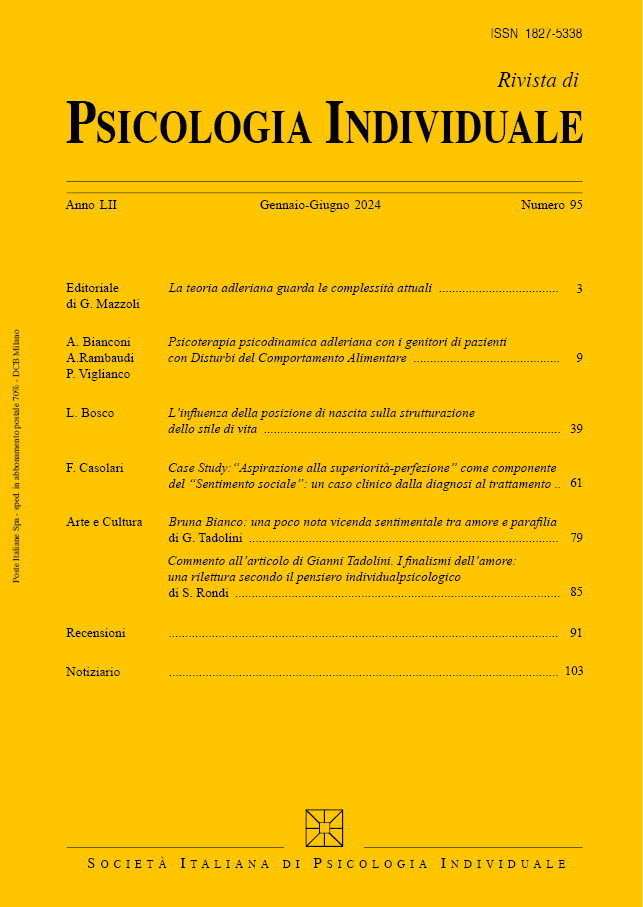
Editorial Rules
Declaration of Originality
-
The Rivista di Psicologia Individuale is the official journal of the SIPI and publishes original articles. The research, subject of the articles, must comply with current legal provisions.
-
Articles must be sent by email in double format (Word and PDF) exclusively to the Editorial Secretariat at the address: rivistasipi@libero.it; they must not be accepted nor under review by other Italian or foreign journals. Articles submitted in other ways cannot be considered. The Director or, in his absence, the Deputy Director may reserve the right to publish submitted or translated articles, providing the reasons for their choice.
-
The Journal is semi-annual. The material to be published, already corrected on a Word file (.docx), must be ready by the end of the third month preceding the release date of the Journal (June - December), in order to respect printing times and the deadline for distribution.
-
The structure of the articles is not rigid; however, if the article presents empirical research, it must contain at least the following paragraphs: Introduction (different from the abstract and longer), Methodology, Results, Discussion, Conclusions. Theoretical articles should still try to follow the proposed structure.
-
The acceptance of works is the responsibility of the Editorial Board, which will promptly inform the Authors. Under no circumstances will the submitted material be returned. Authors may not withdraw, for any reason, nor offer to other Publishers, the article already accepted for publication in the Journal.
-
Authors of articles published in the Journal are entitled to 5 free copies; authors of texts of various kinds (reviews, etc.) are entitled to 2 free copies.
-
The text must be written as follows: title, authors' first and last names; abstract in Italian and English, containing 150-200 words, with the translated title at the beginning; complete text in Italian; 3 keywords. In the attachment, indicate: authors' professional qualification, postal and telephone contact, and tax identification number.
-
Published articles are the literary property of the Publisher, who may authorize partial or total reproduction.
-
The bibliography at the end of the article must be compiled according to standard rules, of which we provide some examples:
9.1. Journals: ADLER, A. (1908), Der Aggressionstrieb im Leben und in der Neurose, Fortschr. Med., 26: 577-584.
9.2. Conference Papers: PAGANI, P. L. (1988), “Finalità palesi e occulte dell’aggressività xenofoba”, IV Congr. Naz. SIPI, Abano Terme.
9.3. Books cited in the original edition: PARENTI, F. (1983), La Psicologia Individuale dopo Adler, Astrolabio, Rome.
9.4. Translated books (always indicate the year and title of the original edition): ELLEMBERGER, H. F. (1970), The Discovery of the Unconscious, tr. it. La scoperta dell’inconscio, Boringhieri, Turin 1976.
9.5. Book chapter (always specify dates if different between the first publication of the chapter-article and the first publication of the book): ROSENHAN, D. L. (1973), Essere sani in posti insani, in WATZLAWICK, P. (ed., 1981), Die erfundene Wirklichkeit, tr. it. La realtà inventata, Feltrinelli, Milan 1988: 105-127.
9.6. The bibliography must be numbered, arranged in alphabetical order by Author, and in chronological order in case of multiple publications by the same Author. In the text, "generic" bibliographic references should be indicated in square brackets with the bibliography number, while specific citations should be indicated in round brackets with the bibliography number and page.
-
When submitting the article to the Editorial Office, the signed Release Form and the Declaration of Originality of the work must also be sent.
-
The Editorial Board reserves the right to make any necessary changes to the text.
-
The evaluation of the works is carried out by Referees who receive the submitted articles anonymously and provide an evaluation (negative, fair, good), followed by a brief critical comment. Works with at least two "fair" evaluations are accepted. The material is then subject to the final judgment of the Editor-in-Chief, who evaluates the definitive acceptance and insertion in the layout.
-
At the end of the Referees' evaluation, the Chief Editor communicates to the Authors whether the submitted article is accepted or not. The non-acceptance of a work will be communicated along with the reasons for the rejection. In any case, the Author is always encouraged to rework the text.
-
Referees are invited to send their judgment to the Editorial Board as soon as possible, and their evaluation is based on the following points:
The proposed topic is of interest to the Journal's readers
The article is original and has never been published
It presents a review of Adlerian literature
It is correct in terms of grammar and syntax
It follows editorial guidelines
The final judgment specifies whether the examined article
- is publishable in its current form or with minimal editing
- publishable after suggested revisions
- publishable in a new version after further review by the Referees
- not publishable.




